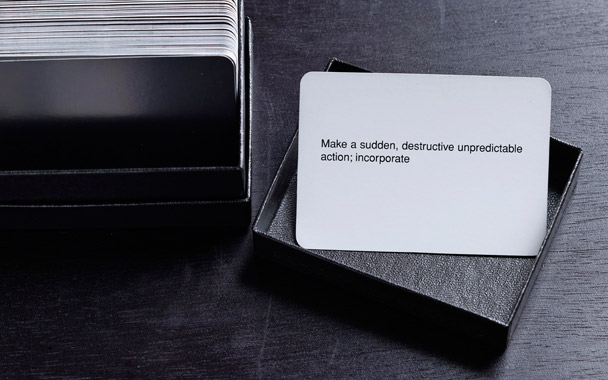“Always first steps”
In 1975 legendary musician and producer Brian Eno—along with artist Peter Schmidt—created a deck of instructional cards designed to disrupt conditioned thought processes and spark creativity.
Modeled on the ancient Chinese I Ching (or Book of Changes), the Oblique Strategies have a cult-like following that primarily comprises musicians (U2, Coldplay, David Bowie) who use the cards during the songwriting and recording process.
With directives such as “Humanize something free of error,” “Make a blank valuable by putting it in an exquisite frame,” and “Gardening, not architecture” the cards can either be used together, as “a set of possibilities being continuously reviewed in the mind,” or individually, with a new card drawn each time a creative dilemma arises. At that point, “the card is trusted even if its appropriateness is quite unclear.” The card is not necessarily meant to be a final suggestion and may simply act as a bridge to newer ideas.
“Once the search is in progress, something will be found”
In his yearlong diary, A Year with Swollen Appendices (Faber & Faber 1995), Eno wrote, “I’m starting to think that all the world’s problems could be solved with either oyster sauce or backing vocals.” He has often used cooking as a metaphor for the artistic struggle to proclaim something never said—or sautéed—before. A Year with Swollen Appendices is peppered with references to oyster sauce, garam masala, and the Zen of cooking. Upon the release of his 1982 album, Ambient 4: On Land, Eno compared the creative process of a cook to improvisation, saying that an intelligent cook will abandon his or her recipes at a certain point: “You taste the dish and you realize there’s the seed of an interesting new taste. So you work on that and forget you were making chicken Kiev, or whatever. You make something new.” And in 2000 he showed how little difference existed between his approach to the kitchen and the studio: “My style of cooking is let’s see what's in the kitchen, and think of something imaginative to do with it. Which is exactly the same idea one has as a producer.”
These metaphors blossom within the Strategies as well, specifically with the proverb “Discover the recipes you are using and abandon them.” And a number of cards seem as though they have been employed by cooks for decades: “Turn it upside down;” “Slow preparation…Fast execution;” and something every cook comes across sooner or later (usually sooner), “Honour thy error as a hidden intention” (aka “I meant to do that”). There are also plenty of cards that communicate to the philosopher chef deep within, such as “Trust in the you of now,” “In total darkness or in a very large room, very quietly,” and “Do we need holes?”
“State the problem in words as clearly as possible”
So how does the deck really hold up in the kitchen?
I decided there was no better place to find out than the Gourmet test kitchen. Our eight cooks develop over 1,000 recipes every year, finding inspiration everywhere, from favorite family dishes to slats of bark on a walnut tree. They’re always looking for new ideas and coming across new challenges. So I downloaded the Oblique Strategies iPhone app and showed it to food editor Ian Knauer, suggesting that he put it to use when he next found himself in need of inspiration on a recipe. Within a few days he was pulling his first card:
“What wouldn’t you do?”
“I had an idea to make mussels with basil and garlic,” he told me. “I was going to call the dish ‘pesto mussels’ or something, but as I was getting ready to cook, Melissa pointed out that two months prior she made a mussel dish with a watercress cream, which, of course, would look exactly the same as ‘pesto mussels.’”
The mussels and basil were already ordered and on their way, so Ian asked Melissa for advice; she suggested pasta. Ian cooked the mussels and pasta and tossed them with the basil, and that’s when the strategy came into play: “There’s an Italian no-no when it come to eating fish with cheese. It’s rarely done. Because it’s such a faux pas, I would never have gone there. But because the card said I should, I did.” In the end, Parmigiano-Reggiano added depth with out strong-arming the more delicate flavors in the dish.
Next, knowing he was on the hook for a dessert for July’s Quick Kitchen, Ian pulled another card:
“Be extravagant”
Right away he knew he wanted to use cream because, as he told me, “extravagance always leads me to only a handful of ingredients, and one that springs to mind immediately in the summer is cream.” He had a start.
He went back to the Strategies and drew: “Define an area as ‘safe’ and use it as an anchor.” One very safe bet was strawberries, and, as Ian reasoned, no one has used them as a more effective “anchor” than yogurt makers. The result: Fruit-on-the-Bottom Tapioca Pudding, extravagant and creamy with an anchor of summertime fruit.
“Are there sections? Consider transitions”
If cooking is an art, then it is certainly prone to the same creative complications and trials as other arts, like writing, painting, or used-car sales: a temporary loss of mojo, a doused spark, a creative block. Or specifically, in this case: chef’s block.
With that in mind, it seems reasonable that Oblique Strategies might be considered as handy a tool and as inspirational as Harold McGee’s On Food and Cooking or perhaps even the Larousse Gastronomique. Sometimes even a clever cook needs a little philosophical guidance.
After all, if the Oblique Strategies can inspire the best from Bowie and Bono, just think what they could do for Batali and Boulud.
“Go outside. Shut the door”




 Pinterest
Pinterest


